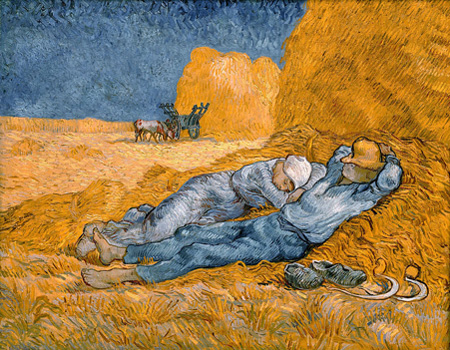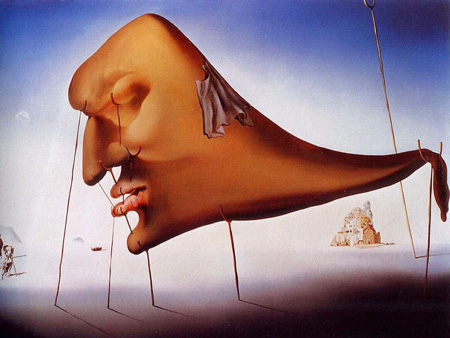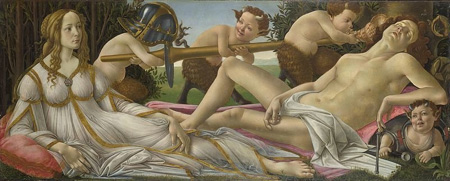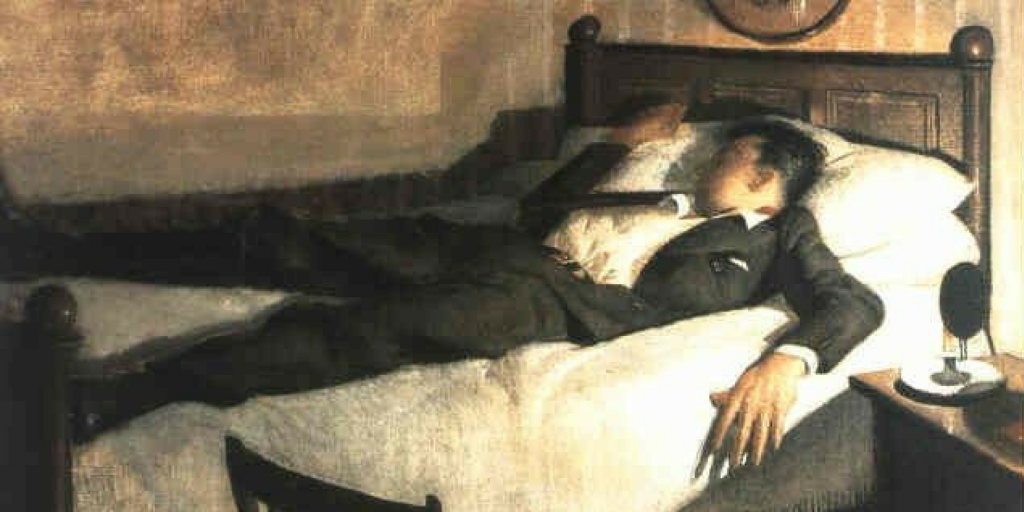Sleep and art go hand in hand through history. A plethora of works on the topic of slumber spans each époque as artists, fascinated with some aspect of sleep, have sought to depict their vision of this everyday human state. From Botticelli to van Gogh, Giorgione to Goya, the viewer has been privy to a secret world, a world normally visited alone; privileged to be invited to explore the artist’s interpretation of the hidden depths of his sleeping brain, where he may be unconsciously exposing his innermost thoughts and urges, normally kept behind the dark curtain of consciousness.

It is helpful to contrast different works, the juxtaposition of different views helping to highlight the lessons to be found in each. One of the most well-known of all sleep works is Vincent van Gogh’s “Noon: Rest from Work (1890).” In this vibrant painting filled with golden yellows and sultry blue hues, Van Gogh depicts sleep as the blissful contrast to labour; the blessing bestowed on the worker by virtue of his activity. In some ways, this is a most restful representation of sleep, as one imagines the quick onset of slumber as tired muscles melt into the supporting mattress of hay underneath the tired bodies of the man and woman. Maybe it is the peace brought about by the harmony between physical and mental fatigue that is what seems so attractive to us in an age when many of us never truly tire physically, or at least to the same extent as our mental and emotional strength is drained by our lifestyles. Since Van Gogh himself was a rather troubled man, painting this particular work while he was interned in a mental asylum in Saint-Rémy de Provence, his depiction of such peaceful sleep tells of a yearning to experience it himself. He may have longed for the simple life of the farmhand, instead of the volatile life of an impassioned painter such as he was. For Van Gogh, sleep was possibly an impossible dream, an unattainable goal and it shows the quality of his work that he so beautifully captures that which he so seldom experienced.

A very different view of the world of sleep was given by Salvador Dali in Le Sommelier (Sleep) (1937). Dali, along with his cohort of Surrealist painters, was greatly influenced by Freud and his Dreamwork theories which he unveiled a mere few decades after Van Gogh’s work.
Freud’s ideas, shocking at the time and even now, examine how our unconscious thoughts are unacceptable to our conscious minds. While conscious thoughts focus on rational goals, like the pursuit of wealth, power or happiness, our unconscious thoughts are about the things that block rational pursuit - unconscious desire, infantile sexuality, hatred, self-destruction and despair. Since we are unwilling to expose these thoughts to ourselves, they can only pass into the conscious via a wish, worry or fantasy that occupies our brain when we are awake. The mechanism of getting into our consciousness is what Freud called the Dreamwork.
It was this process that fascinated the Surrealists, so it is not what they painted, but how they painted it, that is important. Freud showed that when our brain is trying to keep these unconscious thoughts at bay, it reacts by representing these desires by absurdities, everyday items placed together as if they would be found so in normal life, like Dali’s melted watches and swans reflected as elephants. Freud claimed that these are the thoughts that give our lives its richness and despair; rich pickings for passionate artists, then. Dali’s painting of a head on stilts considers the fragility of the barrier of consciousness to irrational desire. Unlike van Gogh’s depiction of restful sleep in the hayfield, Dali’s image is troubled. The man’s expression and the fact that the delicate areas of his face are being propped up by narrow stilts that look likely to snap at any moment, suggest discomfort and a feeling of insecurity. Hardly the ideal for a peaceful night’s rest. Sleep here is a difficult and frightening experience, exposing the inhuman thoughts of the human.
How would Botticelli have felt about exposing such personal descriptions of the private world within his head, unfettered by the moral borders of the Church and frighteningly reminiscent of the untamed human of the dark ages from which the people of medieval times were so desperately trying to disentangle themselves? Botticelli’s Mars and Venus (1483) puts sleep in the context of the mythological Roman gods, where love conquers war as he sleeps. Sleep, in this instance, is used to render Mars weak and vulnerable, depicting the message that love conquers all. Coming from this era in history, survival was so much harder and so the luxury to sleep for the peacefulness of it, or sleep to unleash our inner desires, was perhaps superfluous most of the time. Botticelli probably saw sleep as a necessary part of existence, but only safe to partake of when in trusted company and the experience of it certainly not something to be shared.

We need to ask ourselves whether the perfect state of peaceful slumber is as liberating as the opportunity to release what is really going on behind the veneer of our civilised conscious mind. As humans, does our vulnerability lie in the fact that we can only truly escape difficult realities when we are in peaceful repose, or is it that we can only really escape our unruly unconscious when we are awake? Is Mars the lucky one who has escaped from the dramas of Greek deity, or is it Venus who can look on, with her maidenly aura, in the certainty that she can keep a lid on her underlying desires?
Artists depictions of sleep are influenced both by their own inner world and the world around them. Whether they see sleep as a respite from the vagaries of the conscious world, or whether being awake is gentle relief from the uncontrollable forces unleased in their slumber, our lack of understanding of sleep has offered a vast world of opportunity for the more creatively-minded. Who is to say what another experiences during their repose? As an artist, this must surely be an enticing subject in which to create.
If you are looking to escape into a world of your own, browse our wide range of
mattresses and beds to get inspired.
 It is helpful to contrast different works, the juxtaposition of different views helping to highlight the lessons to be found in each. One of the most well-known of all sleep works is Vincent van Gogh’s “Noon: Rest from Work (1890).” In this vibrant painting filled with golden yellows and sultry blue hues, Van Gogh depicts sleep as the blissful contrast to labour; the blessing bestowed on the worker by virtue of his activity. In some ways, this is a most restful representation of sleep, as one imagines the quick onset of slumber as tired muscles melt into the supporting mattress of hay underneath the tired bodies of the man and woman. Maybe it is the peace brought about by the harmony between physical and mental fatigue that is what seems so attractive to us in an age when many of us never truly tire physically, or at least to the same extent as our mental and emotional strength is drained by our lifestyles. Since Van Gogh himself was a rather troubled man, painting this particular work while he was interned in a mental asylum in Saint-Rémy de Provence, his depiction of such peaceful sleep tells of a yearning to experience it himself. He may have longed for the simple life of the farmhand, instead of the volatile life of an impassioned painter such as he was. For Van Gogh, sleep was possibly an impossible dream, an unattainable goal and it shows the quality of his work that he so beautifully captures that which he so seldom experienced.
It is helpful to contrast different works, the juxtaposition of different views helping to highlight the lessons to be found in each. One of the most well-known of all sleep works is Vincent van Gogh’s “Noon: Rest from Work (1890).” In this vibrant painting filled with golden yellows and sultry blue hues, Van Gogh depicts sleep as the blissful contrast to labour; the blessing bestowed on the worker by virtue of his activity. In some ways, this is a most restful representation of sleep, as one imagines the quick onset of slumber as tired muscles melt into the supporting mattress of hay underneath the tired bodies of the man and woman. Maybe it is the peace brought about by the harmony between physical and mental fatigue that is what seems so attractive to us in an age when many of us never truly tire physically, or at least to the same extent as our mental and emotional strength is drained by our lifestyles. Since Van Gogh himself was a rather troubled man, painting this particular work while he was interned in a mental asylum in Saint-Rémy de Provence, his depiction of such peaceful sleep tells of a yearning to experience it himself. He may have longed for the simple life of the farmhand, instead of the volatile life of an impassioned painter such as he was. For Van Gogh, sleep was possibly an impossible dream, an unattainable goal and it shows the quality of his work that he so beautifully captures that which he so seldom experienced.
 A very different view of the world of sleep was given by Salvador Dali in Le Sommelier (Sleep) (1937). Dali, along with his cohort of Surrealist painters, was greatly influenced by Freud and his Dreamwork theories which he unveiled a mere few decades after Van Gogh’s work.
Freud’s ideas, shocking at the time and even now, examine how our unconscious thoughts are unacceptable to our conscious minds. While conscious thoughts focus on rational goals, like the pursuit of wealth, power or happiness, our unconscious thoughts are about the things that block rational pursuit - unconscious desire, infantile sexuality, hatred, self-destruction and despair. Since we are unwilling to expose these thoughts to ourselves, they can only pass into the conscious via a wish, worry or fantasy that occupies our brain when we are awake. The mechanism of getting into our consciousness is what Freud called the Dreamwork.
It was this process that fascinated the Surrealists, so it is not what they painted, but how they painted it, that is important. Freud showed that when our brain is trying to keep these unconscious thoughts at bay, it reacts by representing these desires by absurdities, everyday items placed together as if they would be found so in normal life, like Dali’s melted watches and swans reflected as elephants. Freud claimed that these are the thoughts that give our lives its richness and despair; rich pickings for passionate artists, then. Dali’s painting of a head on stilts considers the fragility of the barrier of consciousness to irrational desire. Unlike van Gogh’s depiction of restful sleep in the hayfield, Dali’s image is troubled. The man’s expression and the fact that the delicate areas of his face are being propped up by narrow stilts that look likely to snap at any moment, suggest discomfort and a feeling of insecurity. Hardly the ideal for a peaceful night’s rest. Sleep here is a difficult and frightening experience, exposing the inhuman thoughts of the human.
How would Botticelli have felt about exposing such personal descriptions of the private world within his head, unfettered by the moral borders of the Church and frighteningly reminiscent of the untamed human of the dark ages from which the people of medieval times were so desperately trying to disentangle themselves? Botticelli’s Mars and Venus (1483) puts sleep in the context of the mythological Roman gods, where love conquers war as he sleeps. Sleep, in this instance, is used to render Mars weak and vulnerable, depicting the message that love conquers all. Coming from this era in history, survival was so much harder and so the luxury to sleep for the peacefulness of it, or sleep to unleash our inner desires, was perhaps superfluous most of the time. Botticelli probably saw sleep as a necessary part of existence, but only safe to partake of when in trusted company and the experience of it certainly not something to be shared.
A very different view of the world of sleep was given by Salvador Dali in Le Sommelier (Sleep) (1937). Dali, along with his cohort of Surrealist painters, was greatly influenced by Freud and his Dreamwork theories which he unveiled a mere few decades after Van Gogh’s work.
Freud’s ideas, shocking at the time and even now, examine how our unconscious thoughts are unacceptable to our conscious minds. While conscious thoughts focus on rational goals, like the pursuit of wealth, power or happiness, our unconscious thoughts are about the things that block rational pursuit - unconscious desire, infantile sexuality, hatred, self-destruction and despair. Since we are unwilling to expose these thoughts to ourselves, they can only pass into the conscious via a wish, worry or fantasy that occupies our brain when we are awake. The mechanism of getting into our consciousness is what Freud called the Dreamwork.
It was this process that fascinated the Surrealists, so it is not what they painted, but how they painted it, that is important. Freud showed that when our brain is trying to keep these unconscious thoughts at bay, it reacts by representing these desires by absurdities, everyday items placed together as if they would be found so in normal life, like Dali’s melted watches and swans reflected as elephants. Freud claimed that these are the thoughts that give our lives its richness and despair; rich pickings for passionate artists, then. Dali’s painting of a head on stilts considers the fragility of the barrier of consciousness to irrational desire. Unlike van Gogh’s depiction of restful sleep in the hayfield, Dali’s image is troubled. The man’s expression and the fact that the delicate areas of his face are being propped up by narrow stilts that look likely to snap at any moment, suggest discomfort and a feeling of insecurity. Hardly the ideal for a peaceful night’s rest. Sleep here is a difficult and frightening experience, exposing the inhuman thoughts of the human.
How would Botticelli have felt about exposing such personal descriptions of the private world within his head, unfettered by the moral borders of the Church and frighteningly reminiscent of the untamed human of the dark ages from which the people of medieval times were so desperately trying to disentangle themselves? Botticelli’s Mars and Venus (1483) puts sleep in the context of the mythological Roman gods, where love conquers war as he sleeps. Sleep, in this instance, is used to render Mars weak and vulnerable, depicting the message that love conquers all. Coming from this era in history, survival was so much harder and so the luxury to sleep for the peacefulness of it, or sleep to unleash our inner desires, was perhaps superfluous most of the time. Botticelli probably saw sleep as a necessary part of existence, but only safe to partake of when in trusted company and the experience of it certainly not something to be shared.
 We need to ask ourselves whether the perfect state of peaceful slumber is as liberating as the opportunity to release what is really going on behind the veneer of our civilised conscious mind. As humans, does our vulnerability lie in the fact that we can only truly escape difficult realities when we are in peaceful repose, or is it that we can only really escape our unruly unconscious when we are awake? Is Mars the lucky one who has escaped from the dramas of Greek deity, or is it Venus who can look on, with her maidenly aura, in the certainty that she can keep a lid on her underlying desires?
Artists depictions of sleep are influenced both by their own inner world and the world around them. Whether they see sleep as a respite from the vagaries of the conscious world, or whether being awake is gentle relief from the uncontrollable forces unleased in their slumber, our lack of understanding of sleep has offered a vast world of opportunity for the more creatively-minded. Who is to say what another experiences during their repose? As an artist, this must surely be an enticing subject in which to create.
If you are looking to escape into a world of your own, browse our wide range of mattresses and beds to get inspired.
We need to ask ourselves whether the perfect state of peaceful slumber is as liberating as the opportunity to release what is really going on behind the veneer of our civilised conscious mind. As humans, does our vulnerability lie in the fact that we can only truly escape difficult realities when we are in peaceful repose, or is it that we can only really escape our unruly unconscious when we are awake? Is Mars the lucky one who has escaped from the dramas of Greek deity, or is it Venus who can look on, with her maidenly aura, in the certainty that she can keep a lid on her underlying desires?
Artists depictions of sleep are influenced both by their own inner world and the world around them. Whether they see sleep as a respite from the vagaries of the conscious world, or whether being awake is gentle relief from the uncontrollable forces unleased in their slumber, our lack of understanding of sleep has offered a vast world of opportunity for the more creatively-minded. Who is to say what another experiences during their repose? As an artist, this must surely be an enticing subject in which to create.
If you are looking to escape into a world of your own, browse our wide range of mattresses and beds to get inspired.

